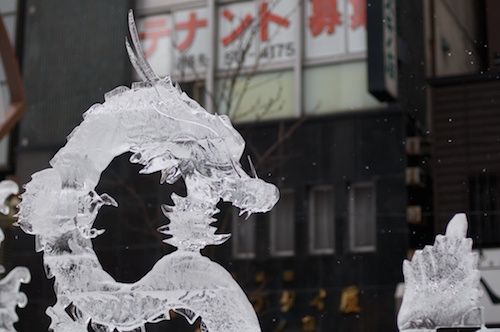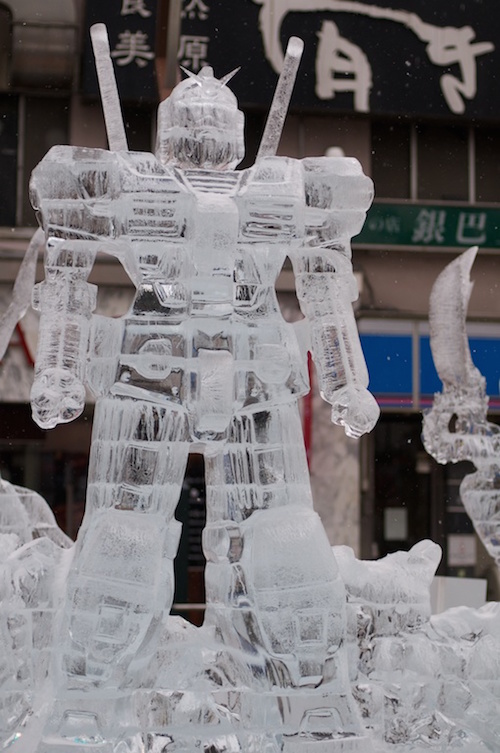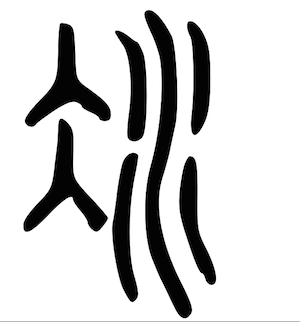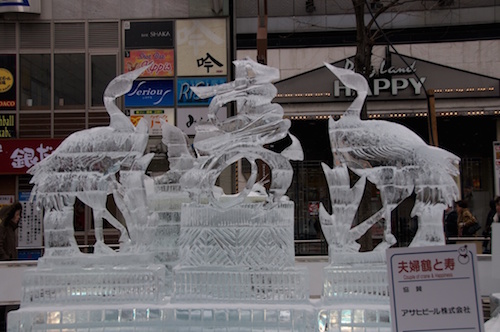15. The "Ice" Radical: 冫
The 冫 radical looks incredibly simple but contains some surprising secrets. For instance, its names in both English and Japanese reveal interesting things.

Photo Credit: Christopher Acheson
Chris Acheson took wonderful pictures of ice sculptures at the Sapporo Snow Festival. All the ice sculpture photos in this Radical Note are his.
What Does にすい Mean?
The Japanese name にすい distinguishes 冫 from the similar-looking 氵 (さんずい), a variant of the "water" radical. You can write that latter radical name in kanji as 三水 (three + water), reflecting the fact that 氵has three strokes. By contrast, the two-stroke 冫 is represented in kanji as 二水 (two + water). It's rare to write either name in kanji; people use hiragana instead. But those kanji renderings certainly make the nomenclature clearer.

This looks like the first of many giant robots known as Gundam from one anime series.
Why Is the "Ice" Radical Called What It's Called?
I was quite surprised to read in Nelson's dictionary (p. 130) that 冫 is known as the "ice" radical because of its use in the early form of the character for ice—namely, this one:

This image (courtesy of Richard Sears) is the seal-script version of 冰, a variant of 氷 (378: ice). The character that the Chinese (but not the Japanese) now write as 冰 used to combine "water" (the flowy bit on the right) with the doubled 人 on the left. That left side represented "cracks in ice," says Henshall.
This character wasn't unusual in featuring a doubled 人 on the left. In fact, that's how the "ice" radical used to look in general.
It seems weird to me that when it comes to the nomenclature of 冫, the Japanese associate this radical with any character at all. Why can't冫 be called the "ice" radical based on the fact that it inherently means "ice"?
Well, that's just the way radicals were often named in both languages. For the sake of convenience and clear communication, people tend to associate radicals with particular kanji. The "one" radical 一 is called that because it's identical to the 一 kanji, which means "one." The "two" radical 二 is exactly like 二, a kanji meaning "two." And the "mouth" radical is 口, just as 口 is a character that represents "mouth."
Unlike the shapes in those examples, 冫 cannot function as an autonomous kanji. Thus, its English name is more comparable to these examples: The "dancing legs" radical 舛 (136) has a name that comes from the bottom of 舞 (1761: dance). Similarly, we can refer to the "net" radical 罒 as あみめ (網目) because that shape represents a net (網, あみ) shaped like the kanji 目 (め). In the same vein, one English name for the "letter H" radical 廾 is "twenty" because 廾 resembles the rare non-Joyo kanji 卄 (twenty).
Given this pattern, I'll just accept that that's the way it's done!
The Position of the "Ice" Radical
Seven Joyo kanji feature 冫as an on-duty radical. In six cases the radical lines the left side of a character, as in these examples:
冷 (604: to cool, chilled; coldheartedness)
凝 (1175: to congeal; stiffen; concentrate; be absorbed in)
凍 (1644: freezing)
Here's the sole exception:
冬 (182: winter)
I suppose we can still call that radical にすい, even though it doesn't look like 冫. There is no other name to use!
Why Is There Ice in These Kanji?
It's not surprising to find "ice" in those four characters, given their meanings. Indeed, the radical means "ice" each time:
冬 (182: winter)
Henshall says this has an obscure etymology but tells us that the shape ultimately depicts "when ice becomes compact," which is to say "winter."
冷 (604: to cool, chilled; coldheartedness)
This character combines "ice" with "order" or "rule," says Henshall. The right side acts phonetically to express "tremble" and "prevail" or "dominate." Thus, he says, the whole character stood for "tremble as a result of prevailing ice," eventually coming to mean "freeze" or "ice-cold."
凝 (1175: to congeal; stiffen; concentrate; be absorbed in)
The left side is "ice." The 疑 means "doubt" in general but acts phonetically here to express "stiff" or "immobile," says Henshall. Thus, 凝 meant "firmly frozen ice," later coming to mean just "stiff" and "immobile." By figurative extension this character then took on the meanings "fastidiousness," "elaborate," and "engrossed."
凍 (1644: freezing)
This character combines "ice" and "east," with the 東 acting phonetically to express "hard" and maybe "mass." Together, the sides mean "hard ice," which symbolizes "freezing," says Henshall.
Photo Credit: Lutlam
The word 弱冷房車 (じゃくれいぼうしゃ: weakly air-conditioned car, weak + air conditioning (next 2 kanji) + car)) indicates that that train car isn't as cold as those with air conditioning on at full blast.
The second kanji in 弱冷房車 features an "ice" radical, and I hoped that the 弱 provided two more instances of this radical. (It would be off-duty, because 弓 (57: bow) is the radical that matters here.) My prayers were not answered. In 弱 (138: weak) the strokes inside the bows are simplifications of 彡 and represent "delicate hairs," says Henshall.
Here's what the rest of the sign says:
この車両は冷房を弱めにしてあります
This car has weaker air conditioning
車両 (しゃりょう: train car); 冷房 (れいぼう: air conditioning);
弱めにする (よわめにする: to make weaker)
What About Less Straightforward Etymologies?
It's less obvious why ice would be in the next three kanji. My sources have broken up the ice for us and provided these analyses:
准 (1376: junior; assistant; semi-, quasi-)
This kanji is a simplification of 準 (709: standard, criterion; semi-, quasi-; to conform, be proportionate to), says Henshall. That other kanji used to feature the "ice" radical instead of the "water" radical, he notes without indicating what the ice contributed to 準 semantically.
凄 (2040: amazing; frightening; to a great extent)
According to Kanjigen, this character consists of ice plus the phonetic 妻 (wife who stands by her husband's side). Together they mean that freezing rain is approaching and that it's piercingly cold—so cold that one feels affected. In Japanese, says the same source, the definitions "tremendous; terrific; terrible" emerged from that idea.
冶 (2119: to work metals)
Kanjigen tells us that the 台 means “to work on something using physical labor." The冫 represents "ice," so 冶 means “to melt and work on metal."

The English in the sign ("Couple of crane & Happiness") is misleading. Here we see a crane (鶴, つる) who constitute a romantic couple (夫婦, ふうふ), not a couple of cranes! I mean, yes, there are two cranes, but you know what I mean. As for "happiness," that middle sculpture is an incredible calligraphic representation of 寿 (1351), which is closer to "celebration" or "good luck" than "happiness." It's the first kanji in 寿司 (すし: sushi).
Behind the 寿 we see a sign with 吟 (1182: to recite; examine carefully). It looks familiar because we've seen so much of 冷, though when I type them, I don't see a close resemblance!
